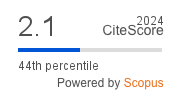Wireless 5G Network in Edge Computing Based On MIMO with Federated Learning and Clustering Integrated Reinforcement Learning
DOI:
https://doi.org/10.4108/eetiot.5910Keywords:
Edge Computing, MIMO, 5G cellular networks, federated learning, resource allocation, energy efficiency and channel optimizationAbstract
Edge Computing (EC) is a revolutionary architecture that brings Cloud Computing (CC) services closer to data sources than ever before. This research proposed novel technique in edge computing network based on wireless 5G technology using MIMO_federated learning integrated with Reinforcement neural network. Here the aim is to enhance the resource allocation by Decentralized Federated learning in multiple user based MIMO (De_Fed_L- MIMO) networks. Then the energy efficiency and channel optimization of the network is carried out using K-means clustering integrated with Reinforcement learning (K-means_RL). Here the experimental analysis is carried out in terms of number of users of network as well as number of edge server by DoF of 92%, Spectral efficiency of 92%, Energy efficiency of 96%, Signal to noise ratio (SNR) of 85%, Coverage area of 92%, RL training accuracy of 95%, FL training accuracy of 98%.
Downloads
References
[1] S. Niknam, H. S. Dhillon, and J. H. Reed, “Federated learning for wireless communications: Motivation, opportunities, and challenges,” IEEE Communications Magazine, vol. 58, no. 6, pp. 46–51, 2020.
[2] W. Y. B. Lim, N. C. Luong, D. T. Hoang, Y. Jiao, Y.-C. Liang, Q. Yang, D. Niyato, and C. Miao, “Federated learning in mobile edge networks: A comprehensive survey,” IEEE Communications Surveys & Tutorials, vol. 22, no. 3, pp. 2031–2063, 2020.
[3] Y. Liu, X. Yuan, Z. Xiong, J. Kang, X. Wang, and D. Niyato, “Federated learning for 6g communications: Challenges, methods, and future directions,” China Communications, vol. 17, no. 9, pp. 105–118, 2020
[4] L. U. Khan, W. Saad, Z. Han, E. Hossain, and C. S. Hong, “Federated learning for internet of things: Recent advances, taxonomy, and open challenges,” arXiv preprint arXiv:2009.13012, 2020.
[5] O. A. Wahab, A. Mourad, H. Otrok, and T. Taleb, “Federated machine learning: Survey, multi-level classification, desirable criteria and future directions in communication and networking systems,” IEEE Communications Surveys & Tutorials, 2021.
[6] Q. Xia, W. Ye, Z. Tao, J. Wu, and Q. Li, “A survey of federated learning for edge computing: Research problems and solutions,” HighConfidence Computing, p. 100008, 2021.
[7] Z. Du, C. Wu, T. Yoshinaga, K.-L. A. Yau, Y. Ji, and J. Li, “Federated learning for vehicular internet of things: Recent advances and open issues,” IEEE Open Journal of the Computer Society, vol. 1, pp. 45– 61, 2020
[8] M. Chen, D. Gund ¨ uz, K. Huang, W. Saad, M. Bennis, A. V. Feljan, and ¨ H. V. Poor, “Distributed learning in wireless networks: Recent progress and future challenges,” arXiv preprint arXiv:2104.02151, 2021.
[9] T. Gafni, N. Shlezinger, K. Cohen, Y. C. Eldar, and H. V. Poor, “Federated learning: A signal processing perspective,” arXiv preprint arXiv:2103.17150, 2021.
[10] S. Hu, X. Chen, W. Ni, E. Hossain, and X. Wang, “Distributed machine learning for wireless communication networks: Techniques, architectures, and applications,” IEEE Communications Surveys & Tutorials, 2021.
[11] H. Hellstrom, J. M. B. d. Silva Jr, V. Fodor, and C. Fischione, “Wireless ¨ for machine learning,” arXiv preprint arXiv:2008.13492, 2020.
[12] S. Dong, P. Wang, and K. Abbas, “A survey on deep learning and its applications,” Computer Science Review, vol. 40, p. 100379, 2021.
[13] S. Dargan, M. Kumar, M. R. Ayyagari, and G. Kumar, “A survey of deep learning and its applications: a new paradigm to machine learning,” Archives of Computational Methods in Engineering, vol. 27, no. 4, pp. 1071–1092, 2020.
[14] Shi, Y., Zhou, Y., & Shi, Y. (2021, July). Over-the-air decentralized federated learning. In 2021 IEEE International Symposium on Information Theory (ISIT) (pp. 455-460). IEEE.
[15] Xing, J., & Hu, D. (2021). Convolutional Neural Network and Clustering-Based Codebook Design Method for Massive MIMO Systems.
[16] Nguyen, V. D., Sharma, S. K., Vu, T. X., Chatzinotas, S., &Ottersten, B. (2020). Efficient federated learning algorithm for resource allocation in wireless iot networks. IEEE Internet of Things Journal, 8(5), 3394-3409.
[17] Pereira-Ruisánchez, D., Fresnedo, Ó., Pérez-Adán, D., &Castedo, L. (2022). A Deep Reinforcement Learning Approach to IRS-assisted MU-MIMO Communication Systems.
[18] Shome, D., Waqar, O., & Khan, W. U. (2021). Federated learning and next generation wireless communications: A survey on bidirectional relationship. arXiv preprint arXiv:2110.07649.
[19] Jere, S., Fan, Q., Shang, B., Li, L., & Liu, L. (2020). Federated learning in mobile edge computing: An edge-learning perspective for beyond 5G. arXiv preprint arXiv:2007.08030.
[20] Tanveer, J., Haider, A., Ali, R., & Kim, A. (2021). Machine Learning for Physical Layer in 5G and beyond Wireless Networks: A Survey. Electronics, 11(1), 121.
[21] Almutairi, M. S. (2022). Deep Learning-Based Solutions for 5G Network and 5G-Enabled Internet of Vehicles: Advances, Meta-Data Analysis, and Future Direction. Mathematical Problems in Engineering, 2022.
[22] Niknam, S., Dhillon, H. S., & Reed, J. H. (2020). Federated learning for wireless communications: Motivation, opportunities, and challenges. IEEE Communications Magazine, 58(6), 46-51.
Downloads
Published
Issue
Section
License
Copyright (c) 2025 Manikandan Parasuraman, Sivaram Rajeyyagari, Ramesh Sekaran, Suthendran Kannan, Vinayakumar Ravi

This work is licensed under a Creative Commons Attribution-NonCommercial-ShareAlike 4.0 International License.
This is an open-access article distributed under the terms of the Creative Commons Attribution CC BY 4.0 license, which permits unlimited use, distribution, and reproduction in any medium so long as the original work is properly cited.




